From Rebuilding to Redeveloping - 1
Moto-machi was close to the hypocenter, and the destruction there was total. After the war, the state-owned land that made up the sprawling military reservation was set aside for public use.
Government offices, a hospital, and schools were planned for eastern Moto-machi while a park was planned for a large portion of western Moto-machi. However, since so many people had lost their homes in the bombing, the area selected for the park was used for emergency housing.
Rebuilding
In January 1946, a Reconstruction Bureau was established by the city of Hiroshima and a plan for reconstruction was vetted and decided upon by the Reconstruction Council, made up of 26 people including representatives from various industries and academic experts.
The new network of streets and the area for land reallocation were decided on October 4, 1946 and shortly after on November 1 it was decided that a majority of the western Moto-machi would be home to a large park.
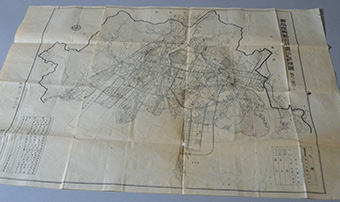
Hiroshima Reconstruction City Planning Map of Parks
The city map of the reconstruction area decided in 1946 shows Moto-machi as a park.
Donated by John D. Montgomery
Improvised Housing
To cope with the post-war housing shortage, the city of Hiroshima decided to take most of the area set aside for the park in Moto-machi and turn it into housing for victims of the war. Since the former military reservation was still managed by the national government, the city was permitted to borrow the land. By the end of fiscal 1946, the Housing Control Association had completed work on 743 residences followed by 1,038 residences under municipal housing and 34 residences for returnees. By 1949, a total of 1,815 residences had been built.
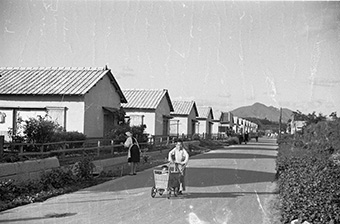
Moto-machi public housing
August-October 17, 1947
Taken by Shunkichi Kikuchi / Courtesy of Tokuko Kikuchi
Of the 743 residences constructed by the Housing Control Association, 267 houses were pre-fab, emergency housing about 23m² with sheet metal roofing and no ceilings. Other houses were also simple, with some using thin bamboo plywood for walls.
In addition, to deal with the housing crisis the city of Hiroshima built 480 residences in June 1946 to get people through the winter, but they were very crude houses with roofs made of chipped wooden boards and no ceilings.
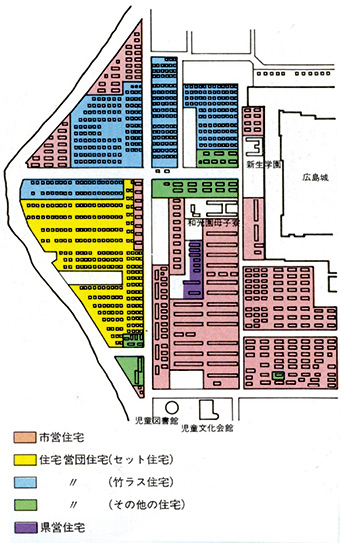
Map of Public Housing in Moto-machi
Distribution of legally built housing and other buildings around 1949
*From Pictorial History of Forty Years since Atomic Bombing Reconstruction of HIROSHIMA
The Construction of Illegal Housing
Although many public housing facilities were built, the housing shortage worsened due to people returning to the city they had fled after the bombing and the repatriation of people who had lived overseas. People who lacked land inevitably began to build shelters along the river banks. The construction of illegal housing was concentrated within the 1.5km strip of land along the Otagawa River from the east side of Aioi Bridge to the east side of Misasa Bridge.
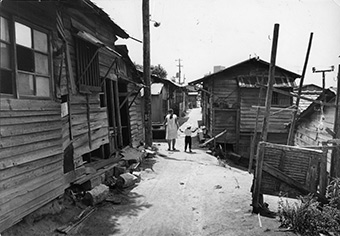
Aioi Avenue
The street taking shape on the banks of the Otagwa River on the western edge of Moto-machi was called Aioi Avenue and was a 2-3 meter wide lane lined on both sides by houses. Sanitary conditions were poor and fires occurred frequently.
August 14, 1967
Taken by Yuichiro Sasaki / Courtesy of Yugo Shioura
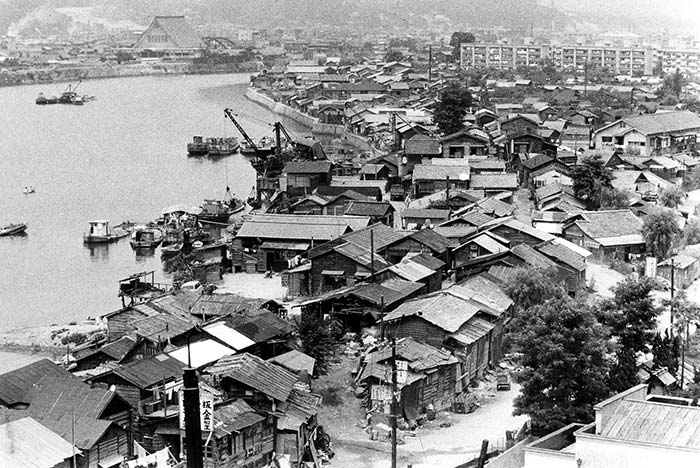
Shacks that crowded onto the banks of the Otagawa River on Moto-machi’s western edge
July 1962 Collection of Chugoku Shimbun
